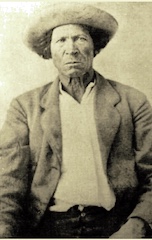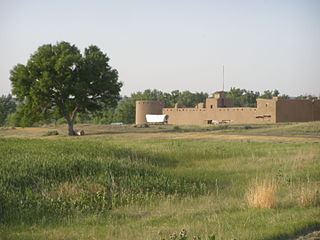Related Research Articles

Charles Bent was an American businessman and politician who served as the first civilian United States governor of the New Mexico Territory, newly invaded and occupied by the United States during the Mexican-American War by the Military Governor, Stephen Watts Kearny, in September 1846.

Bent's Old Fort is a fort located in Otero County in southeastern Colorado, United States. A company owned by Charles Bent and William Bent and Ceran St. Vrain built the fort in 1833 to trade with Southern Cheyenne and Arapaho Plains Indians and trappers for buffalo robes. For much of its 16-year history, the fort was the only major white American permanent settlement on the Santa Fe Trail between Missouri and the Mexican settlements. It was destroyed in 1849.

Ceran St. Vrain, born Ceran de Hault de Lassus de Saint-Vrain, was the son of a French aristocrat who emigrated to the Spanish Louisiana in the late 18th century; his mother was from St. Louis, where he was born. To gain the ability to trade, in 1831 he became a naturalized Mexican citizen in what is now the state of New Mexico. He formed a partnership with American traders William, George and Charles Bent; together they established the trading post of Bent's Fort. It was the only privately held fort in the West.

William Wells Bent was a frontier trader and rancher in the American West, with forts in Colorado. He also acted as a mediator among the Cheyenne Nation, other Native American tribes and the expanding United States. With his brothers, Bent established a trade business along the Santa Fe Trail. In the early 1830s Bent built an adobe fort, called Bent's Fort, along the Arkansas River in present-day Colorado. Furs, horses and other goods were traded for food and other household goods by travelers along the Santa Fe trail, fur-trappers, and local Mexican and Native American people. Bent negotiated a peace among the many Plains tribes north and south of the Arkansas River, as well as between the Native American and the United States government.

The Battle of Cañada was a popular insurrection against the American occupation of New Mexico by Mexicans and Pueblo Indians. It took place on January 24, 1847, during the Taos Revolt, a conflict of the Mexican–American War.

The Taos Revolt was a popular insurrection in January 1847 by Hispano and Pueblo allies against the United States' occupation of present-day northern New Mexico during the Mexican–American War. Provisional governor Charles Bent and several other Americans were killed by the rebels. In two short campaigns, United States troops and militia crushed the rebellion of the Hispano and Pueblo people. The New Mexicans, seeking better representation, regrouped and fought three more engagements, but after being defeated, they abandoned open warfare. Hatred of New Mexicans for the occupying American army combined with the oft-exercised rebelliousness of Taos residents against authority imposed on them from elsewhere were causes of the revolt. In the aftermath of the revolt the Americans executed at least 28 rebels. The Treaty of Guadalupe Hidalgo in 1848 guaranteed the property rights of New Mexico's Hispanic and Native American residents.

Manuel Antonio Chaves or Chávez, known as El Leoncito, was a soldier in the Mexican Army and then became a rancher who lived in New Mexico. His life was full of incident, and his courage and marksmanship became literally legendary in his own time. In documented history, as an American soldier he helped win the American Civil War Battle of Glorieta Pass and was in command during an important fight in the Navajo Wars. As a Mexican soldier he probably negotiated the surrender of a large part of the Texan Santa Fe Expedition.
Thomas Tate Tobin was an American adventurer, tracker, trapper, mountain man, guide, US Army scout, and occasional bounty hunter. Tobin explored much of southern Colorado, including the Pueblo area. He associated with men such as Kit Carson, "Uncle Dick" Wootton, Ceran St. Vrain, Charley Bent, John C. Fremont, "Wild Bill" Hickok, William F. Cody, and the Shoup brothers. Tobin was one of only two men to escape alive from the siege of Turley's Mill and Distillery during the Taos Revolt. In later years he was sent by the Army to track down and kill the notorious Felipe Espinosa and his nephew; Tobin returned to Ft. Garland with their heads in a sack.

Fort Saint Vrain was an 1837 fur trading post built by the Bent, St. Vrain Company, and located at the confluence of Saint Vrain Creek and the South Platte River, about 20 miles (32 km) east of the Rocky Mountains in the unorganized territory of the United States, in present-day Weld County, Colorado. A historical marker notes the place where Old Fort St. Vrain once stood, today at the end of Weld County Road 40, located about seven miles north of Fort Vasquez, Colorado. Among those who helped to establish the fort was Ceran St. Vrain, after whom it was named.

The Trapper's Trail or Trappers' Trail is a north-south path along the eastern base of the Rocky Mountains that links the Great Platte River Road at Fort Laramie and the Santa Fe Trail at Bent's Old Fort. Along this path there were a number of trading posts, also called trading forts.

The Taos Mountain Trail was the historic pathway for trade and business exchanges between agrarian Taos and the Great Plains (Colorado) from pre-history through the Spanish Colonial period and into the time of the European and American presence. The Taos Mountain Trail, between northern New Mexico and southern Colorado, connected the high mountain traders and their trading partners north and south of the Sangre de Cristo Mountains. Also called the Trapper's Trail, the pathway was only wide enough for people on foot or horses in single file, but it shortened a trip from Taos to the plains farther north from nearly two weeks to three days in good weather. The Taos Mountain Trail was also known as the Sangre de Cristo Trail and the Aztec Trail.

The Governor Bent House is the historic home of Governor Charles Bent who served as the first United States territorial governor of New Mexico.

The early history of the Arkansas Valley in Colorado began in the 1600s and to the early 1800s when explorers, hunters, trappers, and traders of European descent came to the region. Prior to that, Colorado was home to prehistoric people, including Paleo-Indians, Ancestral Puebloans, and Late prehistoric Native Americans.
Lewis Hector Garrard was an American travel writer who wrote an enduring book, Wah-to-yah and the Taos Trail, about his visit to the southwestern United States in 1846-1847.

Taos Downtown Historic District is a historic district in Taos, New Mexico. Taos "played a major role in the development of New Mexico, under Spanish, Mexican, and American governments." It is a key historical feature of the Enchanted Circle Scenic Byway of northern New Mexico.

Bent's New Fort was a historic fort and trading post along the banks of the Arkansas River in what is now Bent County, Colorado, about nine miles west of Lamar, on the Mountain Route branch of the Santa Fe Trail. William Bent operated a trading post with limited success at the site and in 1860 leased the fort to the United States government, which operated it as a military outpost until 1867. In 1862, it was named Fort Lyon. The fort was abandoned after a flood of the Arkansas River in 1867.
The Turley Mill and Distillery Site is a historic site on the Rio Hondo about 11 miles (18 km) north of Taos, New Mexico. It was a mill and distillery which served as the headquarters of Simeon Turley's commercial and manufacturing empire. Simeon Turley (1809–1847) and his brothers Stephen Turley (1786–1851) and Jesse B. Turley (1801–1861) transported goods from Franklin, Missouri to Taos via wagon train on the Santa Fe Trail. About 1827–1829 Simeon settled in Arroyo Hondo and established the mill and distillery as a popular trading post and "watering hole." Simeon was murdered in the Taos Revolt of January 1847 and the mill and distillery site was all but destroyed. Simeon Turley is buried in the Kit Carson Memorial Cemetery in Taos. The mill and distillery site was listed on the State of New Mexico Register of Cultural Properties in 1969 and on the National Register of Historic Places in 1978.

Charles Autobees (1812–1882), whose last name was also spelled Urtebise and Ortivis, was a fur trader and pioneer in the American Old West. He was the founder of Autobees, Colorado.
Alexander Barclay was an American frontiersman. After working in St. Louis as a bookkeeper and clerk, he worked at Bent's Old Fort. He then ventured westward where he was a trapper, hunter, and trader. Barclay entered into a common-law relationship with Teresita Sandoval, one of the founders of the settlement and trading post El Pueblo. He helped settle Hardscrabble, Colorado and built Fort Barclay in New Mexico.

Charlotte and Dick Green were enslaved African Americans who worked at Bent's Fort along the Santa Fe Trail in the southwestern frontier, in what is now Colorado. The couple and Dick's brother Andrew came to the fort with Charles and William Bent in the early 1800s and became key figures in the history of the trading post. Charlotte, also called "Black Charlotte", was known for her tasty food and fandango dancing. Dick Green was particularly well known for his role as a soldier, avenging the assassination of then Governor Charles Bent during the Taos Revolt. For his bravery, the Greens were freed and returned to Missouri.
References
Notes
Cited literature
- Comer, Douglas C. (1996). Ritual Ground: Bent's Old Fort, World Formation, and the Annexation of the Southwest. Berkeley: University of California Press.
- Crutchfield, James A., Moulton, Candy & Del Bene, Terry A. (2011). The Settlement of America. New York: Routledge.
- Roberts, Calvin A. & Roberts, Susan A. (2004). A History of New Mexico. Albuquerque: University of New Mexico Press.
- Robertson, Roland G. (1999). Competitive Struggle: America's Western Fur Trading Posts, 1764–1865. Caldwell, Idaho:Caxton Press.
- Thrapp, Dan L. (1988). Encyclopedia of Frontier Biography. Lincoln: University of Nebraska Press.